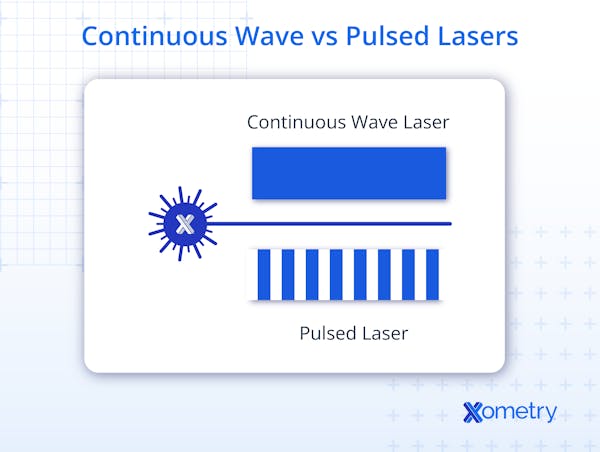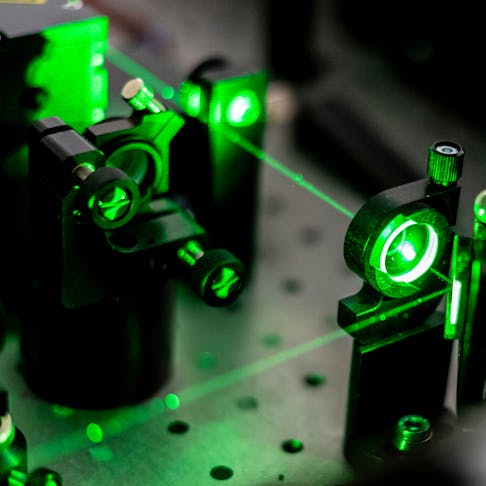Lasers have widespread use in a variety of industries, including medical, fabrication, and scientific research. They are mainly used for cutting, welding, and precise measurement. Continuous wave lasers provide a steady power output, unlike pulsed lasers. Lasers essentially work by using a light or electrical source to excite a medium that emits photons of a specific wavelength and direction, creating a monochromatic light source. Recent advances in ultraviolet laser technology are expected to open up new applications for continuous wave lasers. This article will discuss the definition, inner workings, types, applications, advantages, and disadvantages of continuous wave lasers.
What Is a Continuous Wave Laser?
A continuous wave laser is one of two types of laser, the other being a pulsed laser. It provides a constant light output, while pulsed lasers emit light in bursts. In a continuous wave laser, key parameters such as power output and intensity remain constant during operation. These lasers emit monochromatic light, meaning they produce light at a single wavelength.

How Does a Continuous Wave Laser Work?
To understand how a continuous wave laser works, consider how light is normally produced. In a typical light bulb, energy excites a material, causing it to emit photons spontaneously in all directions. In a laser, a gain medium—usually a crystal or a gas—is excited so that when a photon passes through, it stimulates the emission of additional, coherent photons (i.e., photons with the same wavelength and phase). Mirrors in the laser cavity reflect these photons back and forth, amplifying the beam, while stray spontaneous photons are not amplified. This process results in a single, continuous, coherent light beam exiting the laser.
What Is the Purpose of a Continuous Wave Laser?
The purpose of a continuous wave laser is to provide a constant output. One key advantage is that its steady energy output makes it easier to accurately control exposure time. In contrast, pulsed lasers, with their fluctuating power, make exposure control more challenging.
What Type of Lasers Operate in Continuous Wave Mode?
Each of the different types of lasers capable of operating in continuous wave mode is defined here, and its ability to produce continuous waves is explained:
1. Fiber Lasers
A fiber laser is a laser that has been passed through a fiber optic cable to produce a laser. The internal core of the silica glass optical fiber is doped, usually with Erbium. Erbium is used as it is good at absorbing and emitting photons of the desired wavelength. A light source is pumped into the optical fiber, where stimulation occurs and leads to the emission of the desired light. Light is then amplified through the many reflections occurring in the fiber. A fiber laser is used in laser cutting, drilling, and welding, as well as in optical testing, spectroscopy, and precision measurements.
2. Gas Lasers
Gas lasers pass a stimulating light source through a gas medium to excite the gas element and emit photons. The use of different gases gives the gas laser a range of applications. For example, CO2 lasers are used for high-power applications, including cutting and welding. Whereas, helium-neon lasers are known for alignment and positioning, which lends itself to use in scientific and medical instruments.
3. Semiconductor Lasers
In a semiconductor laser, a forward-biased p–n junction is used, typically employing aluminum gallium arsenide (AlGaAs). The p-type and n-type materials form a junction across which voltage is applied. Electrons flow from one side to the other, and some excess energy creates photons. The photons interact with incoming electrons to create more photons. The photons travel down the gap between the n- and p-type materials and exit the gap as a laser. Semiconductor lasers are used in motion sensors, projectors, and headlamps.
4. Dye Lasers
Dye lasers use a liquid dye solution as the gain medium to produce light. The organic dye within the solution usually degrades from the application of heat, so a reservoir filled with the solution is continuously pumped through the laser. Dye lasers are used in various applications, including medical treatments, spectroscopy, and research.
5. Solid-State Lasers
Solid-state lasers use a solid material such as crystals or glass to create a laser. The crystal or glass is doped with rare earth or transition metal ions. A light source is pumped into the crystal or glass medium to stimulate the medium and create photon emission. Solid-state lasers are used in spectroscopy, material processing, and medical applications.
What Are the Common Applications of Continuous Wave Lasers?
Continuous wave lasers are used for welding, cutting, precision measuring, and alignment across multiple industries. The most common industries that use continuous wave lasers are:
- Material Processing
- Medical and Biomedical Applications
- Telecommunications
- Spectroscopy
- Scientific Research
- Entertainment
- Environmental Monitoring
Is Continuous Wave Laser Technology Used in Cutting?
Yes, continuous wave lasers are used in laser cutting applications. However, pulsed lasers are more common since they can achieve higher peak intensities over short pulses without overheating. This means that pulsed lasers can work at a higher intensity without overheating.
Can a Continuous Wave Laser be Used in Welding?
Yes, a continuous wave laser can be used for welding. Continuous wave lasers require high feed rates, often around 100 inches per minute, to prevent overheating during welding.
How Can a CW Laser Be Used in Medical Procedures Such As Laser Surgery?
Yes, continuous wave (CW) lasers can be used in surgery. Gas lasers can be used to seal blood and lymph vessels and to prevent the spread of tumor cells. They can also be used for the removal of vascular lesions and tumors. Fiber lasers are also used to seal blood vessels and can also be used to debulk cancers in the lungs, stomach, and urological tract. Dye lasers are used to disrupt blood vessels, and solid-state lasers are used to coagulate them.
How Does a Continuous Wave Laser Differ From Other Types of Laser?
A continuous wave laser differs from other lasers as it provides monochromatic light at a constant power output. Other laser types include pulsed and modulating lasers; they differ from continuous wave lasers as they change their output over a given time period. Pulsed lasers release energy in ultra-short pulses, which rise and fall in intensity. Modulating lasers are similar to pulsed lasers, but they are either on or off. Both pulsed and modulating lasers switch between a maximum and minimum energy output, whereas a continuous laser stays at a steady maximum.
What Factors Affect the Output Power and Stability of a Continuous Wave Laser?
Any change or degradation to the medium to which power is supplied to create a laser beam will affect the laser's output and stability. Other factors that affect the power output and stability are:
- The temperature of the laser and the environment
- Vibration
- Poor construction
- Power supply instability
What Are the Advantages of a Continuous Wave Laser?
The main advantage of continuous wave lasers is their stable power output. Other benefits include:
- They are compact
- They are highly efficient
- They have a high power density
- They enable high feed rates in welding applications
What Are the Disadvantages of a Continuous Wave Laser?
The primary limitation of continuous wave lasers is their high cost, and for many applications, cheaper alternatives exist. Other drawbacks include:
- Strict health and safety requirements due to radiation
- Limited cutting thickness in cutting applications
- High energy consumption despite their efficiency
- The need for a stable power source
What Are Some Recent Advances in Continuous Wave Laser Technology?
The use of a continuous wave deep ultraviolet laser has been demonstrated by researchers at the Institute of Materials and Systems for Sustainability (IMaSS) at Nagoya University in collaboration with Asahi Kasei Corporation. A key breakthrough in 2007 enabled the fabrication of high-quality aluminum nitride (AlN) substrates, which led to the successful growth of aluminum gallium nitride (AlGaN)—a material used to build ultraviolet-emitting lasers. This development has opened the door to many new applications for continuous wave lasers, particularly in sterilization and medical fields.
Can a CW Laser Operate in Both Pulsed and Continuous Modes?
Yes, some CW lasers can operate in both pulsed and continuous modes; however, not all lasers have this capability.
Is the Output Power of a CW Laser Constant Over Time?
Yes, the power output of a continuous wave laser is designed to remain constant over time. Stability refers to a laser's ability to maintain that constant output, which is crucial for its intended applications.
Is It Possible To Control the Output Power of a CW Laser?
Yes, the power output of a continuous wave laser can be controlled by adjusting its input signal; however, the laser may require a brief stabilization period after changes are made.
Summary
This article presented the continuous wave laser, explained it, and discussed its various types and applications. To learn more about continuous wave lasers, contact a Xometry representative.
Xometry provides a wide range of manufacturing capabilities, including sheet cutting and other value-added services for all of your prototyping and production needs. Visit our website to learn more or to request a free, no-obligation quote.
Disclaimer
The content appearing on this webpage is for informational purposes only. Xometry makes no representation or warranty of any kind, be it expressed or implied, as to the accuracy, completeness, or validity of the information. Any performance parameters, geometric tolerances, specific design features, quality and types of materials, or processes should not be inferred to represent what will be delivered by third-party suppliers or manufacturers through Xometry’s network. Buyers seeking quotes for parts are responsible for defining the specific requirements for those parts. Please refer to our terms and conditions for more information.


